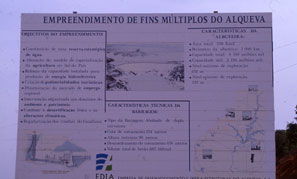|
|
this page is NOT translated
|
 Damsite, year 2000 copyright ERN Roberto Epple more photos |
The European Commission, given the pressure of the Portuguese Government, is financing the construction of the Alqueva dam, one of the biggest dams in the Iberian Peninsula and that would create the largest artificial lake in Europe.
This old project, based in a model of intensive irrigation of a large semi-arid region, is not sustainable and with a incredible low return rate. Given credit to the scientific reports of the same European Commission that is finacing the dam, there is a high probability of desertification and salinization.
Furthermore it will destroy one of the most bio-diversified region in Europe and cause the destruction of thousands of images of irreplaceable ancient rock art (petroglyphs). Over 400 panels of the prehistoric art are located within the impact zone of the dam along the Portuguese and Spanish sides of the Guadiana River.
On February 8th 2002, the 96-metre-high floodgates have been closed but a part of the valley can still be saved. What the opposition is now proposing is:
- a reduction of the level to 147m, or even 136m, diminishing the total volume from 4150 to 3178 hm3.
- a reduction of the submersed area from 29.636ha to 14696ha. This will lead to the reduction of hydroelectric production only between 7 to 12%, to the maintenance of water quality and the reduction in 50% of the destruction of Quercus and other endogenous forests (11861ha to 5673ha) as well to the reduction in the destruction of wet zones (less than 700ha)
Links, articels and more information
Articel (NZZ Neue Zürcher Zeitung) in german (pdf, 1.06.01)
Articel Le Monde, in french,(pdf, 500 kb) 24.01.02
More information from the opposition (Geota Website)
Website Publico.pt (maps, graphics, chronology and more portug. language)Sign the online petition (extern)
Guadiana Mainpage of ERNs RiverNet
Iberian River Mainpag on ERNs RiverNet
Pictures of the Alqueva dam site
(Click to enlarge)
all pictures copyright : R. Epple / European Rivers Network
 Alqueva
dam project
Alqueva
dam project




